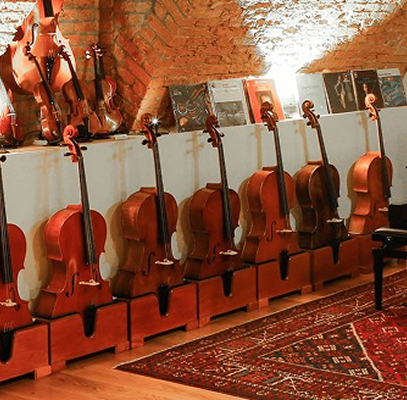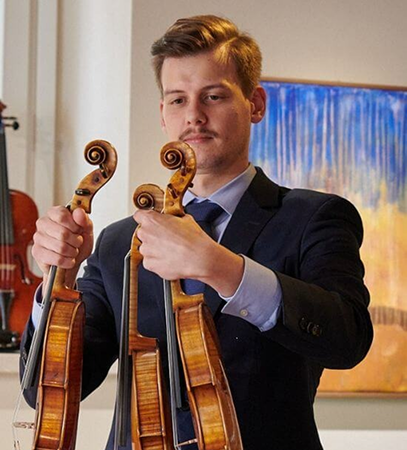Violin Maker
Antonio Stradivari
Cremona, Italy
Antonio Stradivari, born in Cremona, Italy, is widely regarded as the greatest violin maker of all time. Over his prolific career, he crafted around 1,100 instruments, with approximately 650 survivingtoday. His violins, violas, and cellos—especially those from his Golden Period (1700–1720)—are celebrated for their unparalleled tonal brilliance, projection, and beauty. Stradivari's work evolved through distinct phases, including the Amatisé, Long Pattern, and Golden Periods. His legacy continues to inspire luthiers worldwide, with his instruments often valued in the millions of euros.Read more
Short Bio
Full Name: Antonio Stradivari
Highlights
New making style: n/a
Locally making
Cremona, Italy
Maker Background
Antonio Stradivari is one of the greatest violin makers in history, whose instruments are revered for their unmatched craftsmanship, tonal brilliance, and artistic beauty. Born around 1644 in Cremona, Italy, Stradivari is believed to have trained in the workshop of Nicolò Amati. He crafted over 1,100 instruments in his lifetime, including violins, violas, cellos, and guitars. Today, approximately 650 of his works survive, valued at millions of euros.Stradivari's career can be divided into four significant phases—Amatisé Period, Long Pattern Period, Golden Period, and Late Period—each demonstrating his evolving approach to form, sound, and aesthetics. His contributions remain a benchmark in violin-making, shaping centuries of luthiers' craft.
Stradivari's early instruments followed the teachings of Nicolò Amati, with elegant high arching, narrow f-holes, and refined craftsmanship. Violins from this period, referred to as "Amatisé," are characterized by a sweet, lyrical tone and graceful design. However, as Stradivari gained experience, he sought to push beyond Amati's influence by experimenting with body length and arching, aiming to improve projection and tonal complexity.
During this phase, his violins were highly regarded by local musicians, laying the foundation for his growing reputation in Cremona and beyond.
Around 1684, Stradivari introduced a bold design innovation—the Long Pattern violin. These instruments featured an extended body length (approximately 362–364 mm) and flatter arching, which enhanced projection and tonal power. The design was particularly suited for large performance halls, addressing the needs of soloists who required greater sound projection.
While these instruments were acoustically successful, the elongated shape made them challenging to play, leading Stradivari to discontinue the Long Pattern after a few years. Nevertheless, this period was critical in refining the proportions that would define his Golden Period masterpieces.
Stradivari's Golden Period is considered the zenith of his career. Beginning around 1700, he perfected the dimensions and construction of his violins, returning to a shorter body length (356 mm) and refining the balance between arching, f-hole placement, and internal structure. These instruments are renowned for their powerful, rich, and versatile tone, capable of projecting effortlessly in large concert halls while maintaining warmth and clarity.
The varnish used during this period, often a deep red or golden-brown, enhanced the visual allure of the flamed maple and spruce tonewoods. This era produced some of his most famous instruments, including:
The 1715 "Cremonese"
The 1716 "Messiah"
The 1721 "Lady Blunt"
The 1717 "Davidov" cello
In his later years, Stradivari continued to innovate, though his instruments displayed a freer, more spontaneous style. The arching became fuller, and the f-holes and edges often had bolder dimensions. The varnish of these instruments was typically darker and more textured, yet retained Stradivari's characteristic transparency.
Despite these stylistic changes, late-period violins remained acoustically superb, with deep, resonant tones. Instruments such as the 1734 "Habeneck" and the 1736 "Lord Dunraven" exemplify Stradivari’s enduring craftsmanship. His sons Francesco and Omobono assisted in the workshop during this period, ensuring the continuation of the Stradivari legacy.
Antonio Stradivari’s impact on the world of violin-making is immeasurable. His instruments have been played by legendary musicians such as Niccolò Paganini, Itzhak Perlman, and Yo-Yo Ma. Collections such as the Museo del Violino in Cremona and the Royal Academy of Music in London house some of his most celebrated works.
Stradivari’s innovations in form, arching, and varnish continue to influence modern luthiers, who strive to emulate his genius. His name remains synonymous with excellence, and his violins are treasured both for their musical and historical significance.




